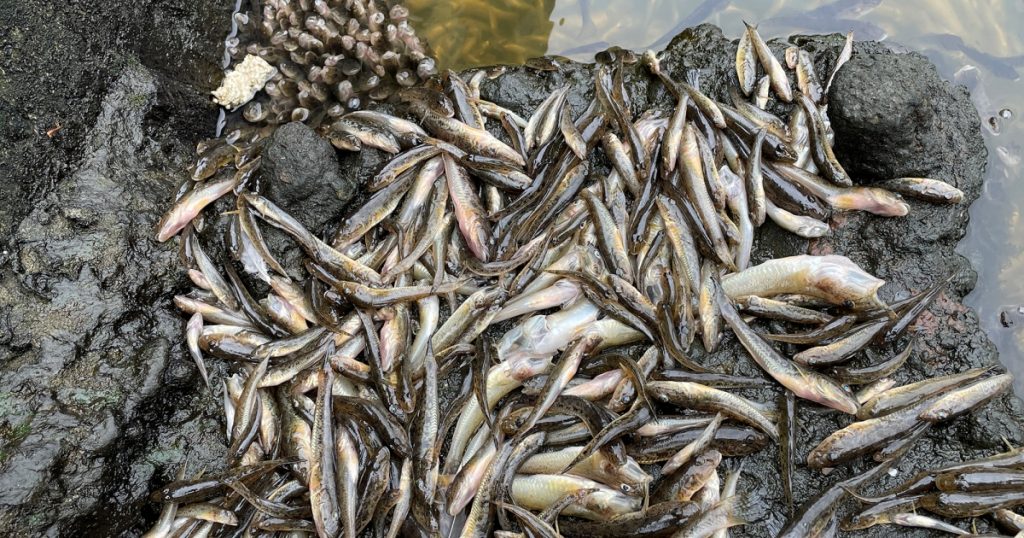Northern California’s Killer Algae Bloom Was Like a “Wildfire in the Water”
Piles of dead yellow-fin goby on the shores of Lake Merritt, Oakland, California, September, 14, 2022.Courtesy of Damon Tighe
This story was originally published by High Country News and is reproduced here as part of the Climate Desk collaboration.
Lake Merritt, in the center of Oakland, California, is a tidal estuary connected to the Pacific Ocean. It usually teems with life, both human and marine. In early September, its 3-mile shoreline was bustling with joggers. But in the sunset-blackened waters, the gleaming white corpses of thousands of decaying fish bobbed along in the gentle tide and piled up in mounds along the lagoon’s edges.
In late July, an algae bloom began spreading in San Francisco Bay, which stretches 60 miles north to south. The bloom has since exploded, expanding north into San Pablo Bay, including the shores of Napa County, and conditions in mid-September were still dire, with the fish kill reaching into the tens of thousands. It is the largest and longest-lasting algae bloom in the bay’s recorded history.
Though the conditions—a combination of warm summer waters, sunlight and heavy nutrients—have been ripe for an algae bloom for decades, the scale of the resulting fish die-off exceeded scientists’ most dire models. Tens of thousands of anchovies, bat rays, striped bass, leopard sharks, bottom-dwelling worms and mollusks—even humongous, decades-old white sturgeon—are washing ashore dead while countless more are sinking to the bottom.
The devastating casualties are linked to an algae bloom of Heterosigma akashiwo. In the first stage of the bloom, H. akashiwo kills fish through some kind of toxic effect, the specifics of which are still unknown. Once the algae start to die, bacteria in the seawater get busy decomposing them, a process which sucks up oxygen, as confirmed by the dissolved oxygen readings taken by scientists throughout Lake Merritt and the bay in early September. And fish can’t survive in oxygen-depleted water. “It’s like a wildfire in the water,” said Jon Rosenfield, a senior scientist at the San Francisco Baykeeper, an environmental advocacy group. “Once this got to a certain stage, there was really nowhere for (the fish) to swim to.”
Lake Merritt was once a healthy estuary that provided water, food and a way of life to the Ohlone people who lived near its shores. But in the 19th century, after pushing Indigenous people out of the area, European colonists used Lake Merritt’s waters as a dumping ground for sewage and wastewater. For decades the city still routed sewage pipes into its waters. As one historian noted, by the turn of the 20th century, Lake Merritt had become “a cesspool and a menace to public health.” It wasn’t until the 1980s that the city began infrastructure projects to clean up the lake, including rerouting the sewage pipes to wastewater treatment plants. Since then, Lake Merritt has seen a steady increase in water quality.
On a recent Sunday in late August, Damon Tighe, a local naturalist who documents Lake Merritt’s incredible biodiversity, went out to Lake Merritt and told me that he was horrified by what he saw. “Every corner had dead gobies”—a type of small bony fish—he said. It was a heart-wrenching reversal of the lagoon’s centuries-long recovery story. Worried about the mounting death toll and frustrated by the lack of public information available, Tighe set up a community science iNaturalist project page, where people could upload their observations of dead fish and compile data points in real time. Because fish decay within days of death, timely data collection is essential for understanding the magnitude of the disaster.
Massive fish die off going on right now in Lake Merritt #oakland #fish #lakemerritt
May be related to the HUGE algal bloom that’s been happening on the east bay since the start of the month in front of Alameda where effluent flows…https://t.co/1H1byxoWOk pic.twitter.com/kU5pH55KVC
— Damon Tighe (@damontighe) August 28, 2022
Keith Bouma-Gregson, a biologist with the US Geological Survey’s California Water Science Center, was taking water samples around the bay when he saw dead sturgeon floating in the water. “That’s like going out to the forest and seeing your old-growth, long-lived species (like redwoods) getting hit pretty hard,” he said. “That was a real sobering moment of recognizing that this this bloom truly was harmful.”
Though the current bloom is unprecedented, it’s not unexpected; this particular species of algae is commonly found throughout the bay. In order to grow, algae need sunlight, warm water and nutrients. In the summertime, San Francisco Bay gets plenty of sunlight. The average temperature of the bay’s waters has also increased over the years, following the general patterns of climate change. And nutrients regularly flow into the water from urban stormwater and agricultural runoff, though the largest contributor by far is recycled sewage from the region’s 37 wastewater treatment plants.
During a recent phone interview, Rosenfield compared the bloom to a catastrophic wildfire where the conditions—created by human mismanagement—are prime for ignition. “The spark is analogous to the cigarette that starts the big wildfire,” he said. “The conditions were always here to start this algal bloom.” Scientists are still working to figure out what exactly set off this year’s destructive bloom, but the key to preventing disasters of this scale is better management. “We know what we can do to mitigate algal blooms or prevent them from happening in the future,” he said.
One solution would be to recycle more water. Restoring the marshes around the bay could also help by sucking excess nutrients out of the water, and it would also provide other benefits to people and wildlife. “But,” Rosenfield said, “policy is slow, and people are slow to spend money until we have disasters.”





